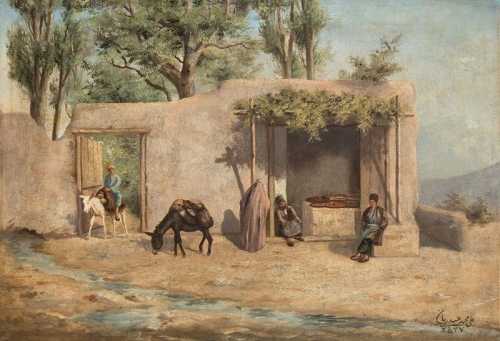Ali Mohammad Heydarian
Iran | 1896 - 1990About Ali Mohammad Heydarian
Iranian painter and teacher Ali Mohammad Heydarian was one of Kamal-ol-Molk's most prominent students. Heydarian received his primary education at the Alliance French School. During the middle of the academic year, he attended the Sanaye Mostazrafeh School with his friend Mohammad Ali Sanati and studied painting under the supervision of Kamal-ol-Molk. As a result of his excellent performance at school, his teacher appointed him as an informal teacher. In order to gain a deeper understanding of Western art, he moved to Belgium and France. Continuing in the tradition of his professor, he contributed significantly to the establishment of the Tehran Faculty of Fine Arts in this regard. The professor began teaching at this university from the very beginning, and in 1964 was promoted to full professor, where he maintained strict and regular classes until his retirement. In most of his paintings, Heydarian depicted still lifes and landscapes, and sometimes he painted single figures. His knowledge of Renaissance and Baroque art was extensive, and he paid particular attention to the Barbizon school of landscape painting. Although he was a prolific artist, he rarely exhibited his work. While he was one of the outstanding students of the Kamal-ol-Molk school and remained dedicated to artistic academicism, especially in the last years of his life, he distanced himself from his master's style of painting and turned to brilliant colors and freestyle brushwork. Mohsen Vaziri Moghadam describes this difference between Heydarian and other followers of Kamal-ol-Molk: "Out of Kamal-ol-Molk's students, only one understood the concept of (classical) art: Ali Mohammad Heydarian. Heydarian is a skilled painter who knows the value of color. Heydarian's faces are not photographs of models but paintings. Although he followed the classical art method, his paintings were not vulgar. In terms of comparing the work of the master and the student, Heydarian's pieces are many times more valuable than Kamal-ol-Molk's own paintings. The value of works by other students of Kamal-ol-Molk does not go beyond the local context."
The Most Expensive Artwork
At Auctions
First Attendance
29 May 2015
# Attendance
5
# Artworks
5
Average Realized Price
19,674 USD
Average Min Estimate
13,061 USD
Average Max Estimate
17,787 USD
Sell-through Rate
80%
Average Growth of Artwork Worth
24.36%
Timeline
The 22nd Tehran - Modern, Classic and Traditional Iranian Art auction
14 February
The 19th Tehran -Classic and Modern Iranian Art auction
24 January
Har Dam Az In Baagh exhibition
2 July
Collectioner 4 exhibition
29 November
هفتمین دوره حراج تهران auction
7 July
پنجمین دوره حراج تهران auction
27 May
چهارمین دوره حراج تهران auction
29 May
